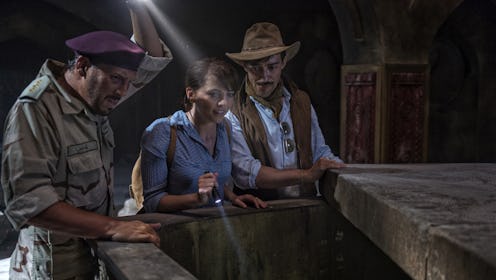Entertainment
'Hooten & The Lady' Are On The Hunt For Some Legendary Loot

Viewers with particularly strong wanderlust may take to The CW's new adventure series, Hooten & The Lady. In the summer premiere, a classy historical expert and a devil-may-care adventurer cross paths accidentally and end up teaming up to find some coveted items. Is the treasure on Hooten & The Lady is real, though?
Of course, the booty would take more than just sunscreen and a compass app to find, but part of the appeal of the series is that the items that Lady Alex and Hooten seek out are based on real famous treasures and artifacts from history. So the series hasn't yet invented any original treasures, even if some of them may have been lost to time or perhaps, never existed outside of legends and lore.
Think of the two leads as a pair of Indiana Joneses, hunting down the Ark Of The Covenant. Sure, the Ark isn't really hidden somewhere in Egypt, equipped with the power to melt Nazi flesh, but it is based on a real historical concept. The Bible says that the Ark Of The Covenant was the gilded case constructed by the Israelites to house the original stone tablets that were inscribed with the Ten Commandments.
Similarly, the treasures on Hooten & The Lady are based on everything from long lost tales to bona fide historical facts. And, since the series originally aired on Sky 1 in 2016, the treasures they found are no mystery. Beware, some slight spoilers are below — but only enough to explain what exactly Ulysses Hooten and Alex look for in each episode.
El Dorado
The lost city of El Dorado may never have been found, but according to National Geographic, the Spanish colonizers became obsessed after hearing a local legend about a particularly far-flung Colombia tribe in the 1500s. The publication states:
"When a new chieftain rose to power, his rule began with a ceremony at Lake Guatavita,". "The new ruler was covered with gold dust, and that gold and precious jewels were thrown into the lake [...] The Spaniards didn't find El Dorado, but they did find Lake Guatavita [...] lowered its level enough to find hundreds of pieces of gold [...] But the presumed fabulous treasure in the deeper water was beyond their reach."
Sibylline Books
The root of the Sibylline Books is "Sibyl," the famous Greek oracle, a woman — and — once the title became an honorific — multiple women. They were all said to have the ability to tell the future, according to the Encyclopedia Britannica. "According to Dionysius of Halicarnassus, a famous collection of sibylline prophecies, the Sibylline Books, was offered for sale," the entry says. After a tough negotiation, the books were sold, but "They were destroyed in the fire of 83 BC."
Alexander's Tomb
According to The Telegraph, archaeologists believed they found Alexander's tomb in Greece in 2015, but "most experts have discounted the Alexander theory, saying that he was probably buried in Egypt," where Hooten & The Lady will travel to find him. According to the BBC, it's also possible the discovered tomb belonged to one of Alexander's generals, or possibly, his mother or sister. But Alexander's remains are still missing.
Bhutanese Buddha Scroll
The majority of Bhutan is Buddhist, and there are ancient Buddhist scrolls dating back to the first century. "Writings from ancient Gandhara in present-day Pakistan and Afghanistan, may represent the oldest surviving Buddhist texts (and also the oldest South Asian manuscripts) ever discovered," says an article on the British Library's site. According to the University of Washington, the Library holds these scrolls today, after they were found stored in a clay pot.
A Faberge Egg
The Imperial series of Faberge Eggs was "created for the Russian Imperial family from 1885 to 1916 [...] the ultimate achievement of the renowned Russian jewelery house," according to the official website. Each egg is covered and filled with precious metals and jewels. According to The Daily Beast, "In the midst of this movement" — as Josef Stalin sold off the eggs to fund his government — "eight eggs vanished seemingly without a trace." The article continues, "Several have never been seen since their original entombment in the Kremlin, inciting nightmares of possible destruction. Others are believed to have been sold early on, but their whereabouts have long been unknown."
Cintamani Jewel
The Tibetan Book Of The Great Liberation is tentatively credited with the first appearance of "King Indrabhuti and the Wish-fulfilling Gem," Cintamani. The text says that, after a series of natural disasters and famines, a blind king "decided to risk his own life for the good of his people and obtain from the Nagas, who dwelt beneath the waters of the ocean, a wondrous wish-granting gem." The story is like an Indian version of the European Holy Grail myth.
Captain Morgan's Treasure
According to CNN, archaeologist Fritz Hanselmann discovered one of Captain Henry Morgan's ships aground in 2012, and the artifacts held inside may not be silver and gold — Hanselmann discovered mostly weapons and supplies — but they are currently on display in Panama City. And Hanselmann's work continues. He unearthed another merchant ship in the same area in 2015, according to National Geographic. If Hooten & The Lady really wanted to find Morgan's treasure, they'd have to contend with the real explorers attempting to uncover the same thing.
So while Hooten & The Lady is not based on a true story, it might inspire you to do some virtual digging to find out even more about the treasures they're after.